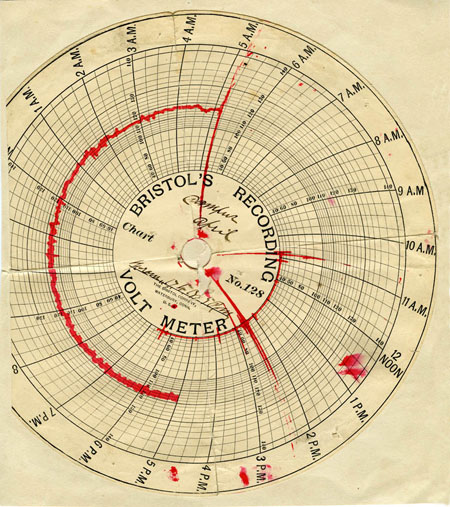|
|
||||||||||
 |
|
|
|
|||||||
|
|
||||||||||
|
|
|
|
|
|
|
|
|
|||
|
|
|
|
|
|
|
|
|
|
|
|
Gallery | Documents | Voltmeter

Voltmeter
Stanford supplied its own power in 1906, just as it does today. The old powerhouse with its 100-foot smokestack was located next to the engineering buildings. According to the night watchman, the University fireman, Otto Gerdes, was in the powerhouse when the quake struck. He started to run for the door, then wheeled around and raced back to the main electrical power switch, yelling, “They’ll all be on fire.” He cut electricity to the campus, but was killed by the collapsing smokestack as he tried to escape – one of only two casualties in the earthquake.
Interestingly, a Bristol recording voltmeter that was housed in the powerhouse to track generated voltage behaved like a modern seismograph during the 1906 quake. This device consisted of a clockwork mechanism with a circular chart that was changed daily. A pen, restricted to one axis, recorded the voltage on the chart. Up to 5:12 AM on April 18th, the recording pen traced the voltage as usual (Fig. 15). At that point, the shaking caused the pen to move rapidly for 53 seconds, after which the power was broken. The clockwork mechanism remained intact after the collapse of the smokestack, and the pen continued to record the aftershocks, showing major ones occurring at 10:48 AM and 2:28 PM. Finally, the clockwork mechanism ran down and the voltmeter stopped recording at around 6:40 PM.
While actual seismographs of the day were much more sensitive pieces of equipment, the voltmeter is notable for recording similar information. It is interesting to note that the shock the voltmeter recorded at 10:48 is a bit of a mystery as there are no recorded reports of aftershocks felt at that time. The 2:28 aftershock was widely reported, however.
A document that is kept with the voltmeter recording in Stanford's University Archives says the following:
"I have before me an interesting souvenir of the day, in the form of the round paper chart driven around by clockwork and used to record the power house voltage. At 5:13 AM the red ink pen on the end of the recording arm seems to have gone crazy. It has traced a line from the outside of the paper to the centre, where the pen stuck. A later quake has shaken it loose and from then on, it would have traced a perfect circle at zero volts, if it had not been disturbed by further earthquakes. I can count sixteen of them in the next few hours, some of them quite violent. Although not a seismograph, or instrument for recording earthquakes it automatically has acted as one." Cyril F. Elwell, '07